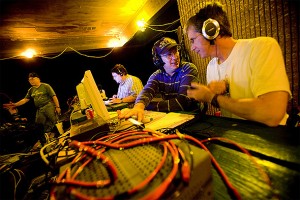Ham Radio Operators provide valuable service when severe weather strikes
April 20th, 2012 by Ric Hanson
When a string of tornadoes hit the Central U-S and Great Lakes Region the weekend of April 14th, communications in some of those areas was knocked out, leaving local officials with no way of calling for help or reporting damage. That’s where HAM radio operator’s stepped-in.
Tom Reis, SKYWARN Coordinator for the Des Moines National Weather Service Office, says just before an EF-2 tornado hit Creston, causing severe damage to the hospital and other structures, amateur radio, or “HAM” operators in Creston reported storm observations directly to the National Weather Service. Reis says they’re a valuable asset to discerning information that could help save lives.
When severe weather is imminent, the National Weather Service office in Des Moines calls in one of four trained operators to come out and coordinate HAM communications. When the storms hit April 14th, Reis, who lives nearby, was called into action. He says at 6:59-p.m., he was in contact with an amateur radio operator who lives two-miles west of Creston. One minute later, he spoke with an operator in Creston. Both were reporting hail. He says if the tornado had not been rain-wrapped, it’s likely both operators would have seen it and given warning to the Weather Service before it hit. Reis says the radar signature for the tornado was very brief , and almost imperceptible. He says by the time they could “Pull the trigger” on warning residents, the twister had left the Creston area. After the storm passed, HAM operators began to provide communications support to local officials.
The Weather Service learned from the radio op’s the hospital had been hit and there were injuries. That information Reis says, was very valuable, and enabled officials to direct State resources to the area. He says the day following the storm, officials discovered that the local school district lost the 80 foot tower that is used for the school bus repeater. The Creston Amateur Radio Club offered their antenna, coax and space on their 200-foot to the school.
Reis it doesn’t take much to become an amateur radio operator, and people of all ages enjoy the hobby, which also provides a service. For more information, go to www.dmraa.com. He also recommends everyone attend a free Spotter Training course, and purchase a NOAA Weather radio. The six-digit codes can be programmed with assistance from your local Emergency Management Office, or by finding your county and surrounding county codes at www.nws.noaa.gov/nwr/nwrrcvr.htm.






